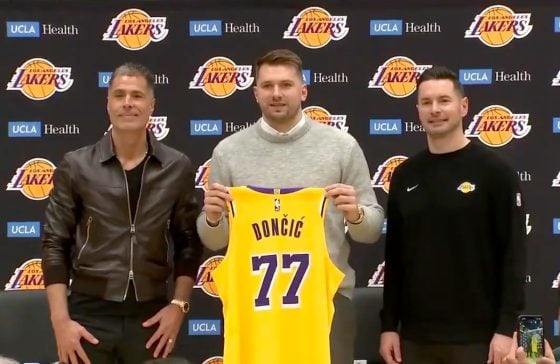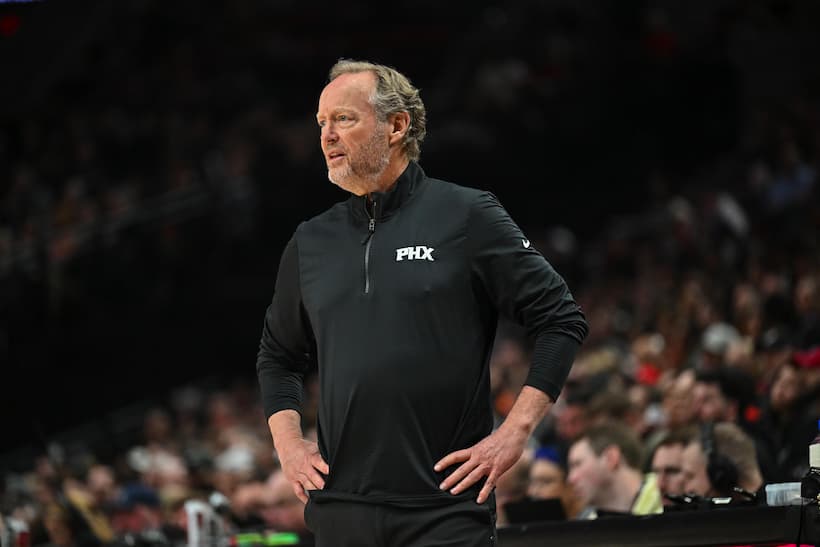Key Highlights:
-
- Anthony holds career-highs in true shooting percentage (60.6), two-point percentage (51.0), three-point percentage (42.9) and free-throw rate (.429)
- A career-best 46 percent of his shots are coming off of assists
- Orlando needs more floor-spacing, ball-handling guards like him
When Cole Anthony checked into Monday’s game midway through the first quarter, his Orlando Magic were knotted at 19 with the Dallas Mavericks. Five minutes later, before Anthony even attempted his first shot, Orlando had built a 38-29 lead.
The fourth-year guard wasn’t merely a passenger along this 19-10 ride either. He played a crucial role in the Magic gaining some separation, running the offense, collecting four assists, and drawing a shooting foul against a late arriving closeout. Of the 19 points Orlando scored, he had a hand in 11 of them. Across those five minutes, he didn’t hoist a single shot. For someone whose scoring ethos has typically been assumed to dominate his contributions, Monday’s stretch — and his entire start to the 2023-24 — represents a blossoming.
Anthony, who inked a three-year, $39 million extension last month, is a good NBA player. He’s playing terrific basketball for a Magic club that sits tied for fifth in the East at 4-3. Through seven games, he’s averaging 15.9 points, 4.4 rebounds and 2.9 assists in 24.9 minutes per night. He’s shooting 42.9 percent beyond the arc and 51 percent on two-pointers, both career-best marks. His 60.6 percent true shooting is a career-high and 3.6 points above league average — another career-high. As Orlando aims to clarify its core, particularly in the backcourt, his development is making clear his staying power.
What’s Changed In Anthony’s Game?
One of the starkest and most integral shifts is his approach as an initiator. With jabs, crossovers and hesitations, he’s a savvy ball-screen operator who routinely encounters space to hit the paint. Early in his career, he tended to immediately turn that space into quick pull-ups or intrepidly challenge a rim protector inside. They weren’t always bad decisions or outcomes, just ones that left many options on the table.
He’s certainly showcased some passing chops previously, but shooting and passing felt like divorced ideas rather than symbiotic concepts. Nowadays, he scans the floor and operates as someone considering both shooting and facilitating. He serves up the easy dimes, probes to pressure defenders and keeps his dribble alive longer.
He’s assured he can extend touches to execute the ideal play, not just a play. The game has slowed. There’s a reason players and coaches espouse that cliche when discussing improvement — because it’s the truth. For Anthony, the game slowing has unlocked how he utilizes the paint touches he constantly generates. He maneuvers with purpose. Superfluous movements and routes have been trimmed down. He does not make decisions for the sake of making decisions; he makes decisions with intention.
Although he’s not much of an anticipatory playmaker, he knows how to find and fashion space for himself and his teammates. It’s perhaps his superlative trait as a ball-handler, and it’s a valuable one. Instead of parlaying that attention into a tough shot-making display, he’s letting others thrive in the space he pries open.
Anthony’s refined patience and cadence are boons for his scoring efficiency, too. He isn’t forcing up shots. If he slaloms into the paint and bends the defense, he’s more willing to swing the ball elsewhere and trusts that a better look than whatever he initially saw will arise. In 2021-22, he averaged 86 touches per 36 minutes, according to NBA.com. This season, he’s averaging 80.2. The major difference is time of possession: 6.3 vs. 4.5 seconds.
As a result, his off-the-bounce burden has dwindled and his efficiency during those opportunities has swelled. Per PBPStats, a career-low 58.4 of his field goals are self-created, while he sports a career-high effective field goal percentage of 56.7 on those attempts; prior to this year, his extremes in those respective categories were 66.6 percent and 49.1 percent.
The arrivals of Franz Wagner and Paolo Banchero surely prompt an adjustment, but he’s also welcomed that adjustment and molded his game accordingly. Discretion is his friend.
Whether it’s dropping in floaters or battering his way to the charity stripe, Anthony is flourishing as a slasher. According to Cleaning The Glass, 28 percent of his shots are coming at the rim, his highest rate since 29 percent during his rookie season.
Despite only shooting 40 percent there (6-of-15), it’s helped him parade to the foul line and his .429 free-throw rate blows past his previous best of .279 last year. Sometimes to a fault, he’s never been shy about embracing contact around the hoop. It’s benefitting him to open 2023-24.
Countering his shaky finishing and good-not-great free-throw shooting (75.8 percent this year, 85.5 percent for his career) is a gnarly intermediate arsenal. He’s knocked down 56 percent (19-of-34) from midrange. His timing and footwork manufacture driving lanes. Paint touches themselves haven’t eluded him throughout his carer, but chaos invaded them too regularly. This season, that’s yet to be a common issue. He’s reaching the paint and settling on keen decisions.
Netting 42.9 percent (12-of-28) of his triples, the former Tar Heel is off to a roaring start from deep. That’s probably unsustainable, but spot-up threes compose a career-high 27.3 percent of his shots and he’s nailed 38.1 percent (8-of-21) of them. It’s not inconceivable he posts a new high-water mark beyond the arc because of his selectivity and the infrastructure around him.
A lot of the daunting, potential highlight-reel buckets he used to pursue have been swapped for replicable makes. Never before have fewer than 37.2 percent of his field goals been pull-up jumpers. This year, they’re 28.6 percent of his diet; he’s only launching one pull-up three per game (4-of-7, 57.1 percent).
What Does Anthony’s Growth Mean For The Magic?
Part of Anthony’s importance is tied to his unique skill-set among Orlando’s backourt rotation. Solely Gary Harris, who’s currently sidelined, stretches the floor like him and he doesn’t offer much ball-handling juice. Markelle Fultz, Jalen Suggs and Anthony Black are all either drive-first guards and/or creaky shooters.
Banchero and Wagner — the latter of whom is a viable spacer — want to drive and inhabit the paint as well. All that overlap leads to some ugly stretches offensively desperate for off-ball shooting and secondary creation from multiple guards. On Monday, Orlando raced out to a 15-point, first-half lead before Dallas loaded the paint, dared the Magic to spray home three-pointers and won the second half, 64-36.
The Magic absolutely missed Fultz. His driving and playmaking invigorate the offense. Yet Banchero and Wagner are the long-term hubs for Orlando and he remains a dicey scorer. Their optimization requires guards who can shoot and play in tandem with them.
Anthony is of that ilk, but I’m skeptical he’s good enough to be the foremost version of this archetype. Even if he is, they must find more than one copy. Albeit to differing degrees, defenses don’t really respect Fultz, Suggs and Black as scorers. It significantly mitigates the appeal of such a malleable frontcourt (Banchero, Wagner, Wendell Carter Jr.). That trio should be a bastion for schematic versatility. Instead, they’re hamstrung by the backcourt’s scoring woes.
Orlando is not stuck in a bad position so much as it’s nearing a crossroads with these guards and the collective roster-building. It owns all its future first-round picks, as well as the Denver Nuggets‘ 2025 first (protected 1-5) and a 2026 pick swap from the Phoenix Suns or Washington Wizards. Fultz, Suggs and Black are all good players or intriguing prospects. The flexibility to solve this problem exists.
Other youngsters like Jett Howard or Caleb Houstan could sweeten a deal or be the direct solution as well. They’re both heralded as high-level shooters, though skew closer to forward status than guard. Even so, giving them a crack at a guard spot long-term could be worthwhile. At worst, it further emphasizes the demand to address this hole.
The Magic are good enough to reach the postseason this year. Making noise there requires answering some important questions. Banchero and Wagner are future All-Stars. Anthony complements them well. For all his growth and utility, however, his presence is not a magic elixir. He is an outline of the consummate backcourt members next to Banchero and Wagner. Orlando’s future should include him. He’s earned that designation. But more work is necessary for the Magic to maintain their ascension. A pressing challenge awaits.






